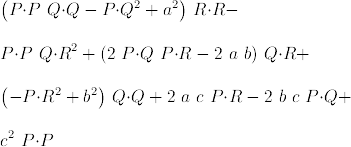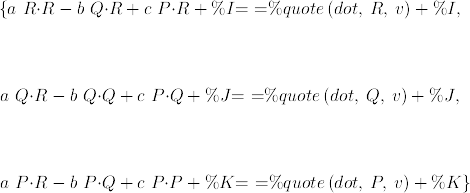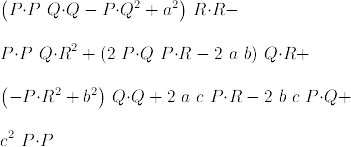|
|
|
last edited 14 years ago by page |
Edit detail for SandBoxGrassmannIsometry revision 5 of 7
| 1 2 3 4 5 6 7 | ||
|
Editor: page
Time: 2009/09/11 17:19:15 GMT-7 |
||
| Note: new representation | ||
added: Isometry from Grassmann Multivectors Representation 'K' is a unital associative and commutative ring represented by polynomials with rational coefficients of a set of symbols. \begin{axiom} K:=SparseMultivariatePolynomial(Fraction Integer,Symbol) \end{axiom} The Grassmann Hopf K-algebra is represented by the Axiom domain **Expression** consisting of rational functions with coefficients from K over an additional set of symbols and common mathematical operators. \begin{axiom} E:=Expression K a:=a::Symbol::K; b:=b::Symbol::K; c:=c::Symbol::K; P:=P::Symbol::E; Q:=Q::Symbol::E; R:=R::Symbol::E; \end{axiom} changed: -dot(A:EXPR INT,B:EXPR INT):EXPR INT == (smaller?(A,B)=>idot(A,B);idot(B,A)) -dot(P, Q)=dot(Q,P) dot(A:E,B:E):E == (smaller?(A,B)=>idot(A,B);idot(B,A)) test(dot(P, Q)=dot(Q,P)) changed: -hat(A:EXPR INT,B:EXPR INT):EXPR INT == (smaller?(A,B)=>ihat(A,B);-ihat(B,A)) -hat(P, Q)=-hat(Q,P) hat(A:E,B:E):E == (smaller?(A,B)=>ihat(A,B);-ihat(B,A)) test(hat(P, Q)=-hat(Q,P)) changed: -6 Proof of the main theorem 15 (isometry from bivector) 5 Isometry from Bivector In 1937 Elie Cartan observed that the Lie algebra of the isometry group $ O_g = Aut(E,g) $, is given by bivectors $E^{\wedge 2} \subset \mathcal{Cl}(E,g)$. changed: -eq33 := matrix [[-dot(P,P), -dot(P,Q)+c], _ - [dot(Q,P)+c, dot(Q,Q)]] eq33 := matrix [[-dot(P,P), dot(Q,P)+c], _ [-dot(P,Q)+c, dot(Q,Q) ]] added: Consider the following endomorphism, \begin{equation} L \equiv id_E - P \otimes \alpha - Q \otimes \beta - R \otimes \gamma \ \ \in End_K E \end{equation} \begin{equation} t \equiv P \wedge Q \wedge R \ne 0, \mbox{and} \alpha \wedge \beta \wedge \gamma \ne 0 \end{equation} changed: -eq44 := matrix [[dot(P, P), dot(P, Q)+a, dot(P, R)+b], _ - [dot(P, Q)-a, dot(Q, Q), dot(Q, R)+c], _ - [dot(P, R)-b, dot(Q, R)-c, dot(R, R)]] eq44 := matrix [[dot(P,P), dot(Q,P)-a, dot(R,P)-b], _ [dot(P,Q)+a, dot(Q,Q), dot(R,Q)-c], _ [dot(P,R)+b, dot(Q,R)+c, dot(R,R) ]] changed: -eq47a.adjMat eq47a.adjMat::List List E )set output tex on removed: -)set output tex on added: changed: - a*dot(R, R)-b*dot(R, Q)+c*dot(R, P) == dot(R, v) - a*dot(Q, R)-b*dot(Q, Q)+c*dot(Q, P) == dot(Q, v) - a*dot(P, R)-b*dot(P, Q)+c*dot(P, P) == dot(P, v) a*dot(R,R)-b*dot(R,Q)+c*dot(R,P) == dot(R,v) a*dot(Q,R)-b*dot(Q,Q)+c*dot(Q,P) == dot(Q,v) a*dot(P,R)-b*dot(P,Q)+c*dot(P,P) == dot(P,v)
Isometry from Grassmann Multivectors
Representation
K is a unital associative and commutative ring represented by polynomials
with rational coefficients of a set of symbols.
axiom
K:=SparseMultivariatePolynomial(Fraction Integer,Symbol)
| (1) |
Type: Domain
The Grassmann Hopf K-algebra is represented by the Axiom domain Expression consisting of rational functions with coefficients from K over an additional set of symbols and common mathematical operators.
axiom
E:=Expression K
| (2) |
Type: Domain
axiom
a:=a::Symbol::K; b:=b::Symbol::K; c:=c::Symbol::K;
Type: SparseMultivariatePolynomial?(Fraction(Integer),Symbol)
axiom
P:=P::Symbol::E; Q:=Q::Symbol::E; R:=R::Symbol::E;
Type: Expression(SparseMultivariatePolynomial?(Fraction(Integer),Symbol))
Grassmann Algebra Operators
Symmetric inner product
axiom
idot:=display(operator('dot,2), (x:List OutputForm):OutputForm +->
hconcat([x.1,_{_\cdot_} ,x.2]));
Type: BasicOperator?
axiom
dot(A:E,B:E):E == (smaller?(A,B)=>idot(A,B);idot(B,A))
Function declaration dot : (Expression(SparseMultivariatePolynomial( Fraction(Integer),Symbol)),Expression( SparseMultivariatePolynomial(Fraction(Integer),Symbol))) -> Expression(SparseMultivariatePolynomial(Fraction(Integer),Symbol) ) has been added to workspace.
Type: Void
axiom
test(dot(P, Q)=dot(Q,P))
axiom
Compiling function dot with type (Expression(
SparseMultivariatePolynomial(Fraction(Integer),Symbol)),
Expression(SparseMultivariatePolynomial(Fraction(Integer),Symbol)
)) -> Expression(SparseMultivariatePolynomial(Fraction(Integer),
Symbol))| (3) |
Type: Boolean
Exterior product
axiom
ihat:=display(operator('hat,2), (x:List OutputForm):OutputForm +->
hconcat([x.1,_{_\wedge_} ,x.2]));
Type: BasicOperator?
axiom
hat(A:E,B:E):E == (smaller?(A,B)=>ihat(A,B);-ihat(B,A))
Function declaration hat : (Expression(SparseMultivariatePolynomial( Fraction(Integer),Symbol)),Expression( SparseMultivariatePolynomial(Fraction(Integer),Symbol))) -> Expression(SparseMultivariatePolynomial(Fraction(Integer),Symbol) ) has been added to workspace.
Type: Void
axiom
test(hat(P, Q)=-hat(Q,P))
axiom
Compiling function hat with type (Expression(
SparseMultivariatePolynomial(Fraction(Integer),Symbol)),
Expression(SparseMultivariatePolynomial(Fraction(Integer),Symbol)
)) -> Expression(SparseMultivariatePolynomial(Fraction(Integer),
Symbol))| (4) |
Type: Boolean
axiom
simplifyHat:=rule dot(P, Q)^2-dot(P,P)*dot(Q,Q) == hat(P,Q)^2 -dot(P,Q)^2+dot(P,P)*dot(Q,Q) == -hat(P,Q)^2 dot(Q,R)*dot(P,R)-dot(R,R)*dot(P,Q) == dot(hat(R,Q),hat(R,P))
 | (5) |
Type: Ruleset(Integer,SparseMultivariatePolynomial?(Fraction(Integer),Symbol),Expression(SparseMultivariatePolynomial?(Fraction(Integer),Symbol)))
- Isometry from Bivector
In 1937 Elie Cartan observed that the Lie algebra of the isometry group
 , is given by bivectors
, is given by bivectors  .
.
axiom
eq33 := matrix [[-dot(P,P), dot(Q,P)+c], _
[-dot(P,Q)+c, dot(Q,Q) ]]
| (6) |
Type: Matrix(Expression(SparseMultivariatePolynomial?(Fraction(Integer),Symbol)))
axiom
eq35 := inverse(eq33)
 | (7) |
Type: Union(Matrix(Expression(SparseMultivariatePolynomial?(Fraction(Integer),Symbol))),...)
axiom
map(x+->simplifyHat(x),eq35)
 | (8) |
Type: Matrix(Expression(SparseMultivariatePolynomial?(Fraction(Integer),Symbol)))
- Isometry from Trivector
Consider the following endomorphism,
| (9) |
| (10) |
axiom
eq44 := matrix [[dot(P,P), dot(Q,P)-a, dot(R,P)-b], _
[dot(P,Q)+a, dot(Q,Q), dot(R,Q)-c], _
[dot(P,R)+b, dot(Q,R)+c, dot(R,R) ]]
 | (11) |
Type: Matrix(Expression(SparseMultivariatePolynomial?(Fraction(Integer),Symbol)))
axiom
eq47a := adjoint(eq44);
Type: Record(adjMat: Matrix(Expression(SparseMultivariatePolynomial?(Fraction(Integer),Symbol))),detMat: Expression(SparseMultivariatePolynomial?(Fraction(Integer),Symbol)))
axiom
)set output tex off
axiom
)set output algebra on
eq47a.adjMat::List List E
(17) [ 2 2 [Q{\cdot}QR{\cdot}R - Q{\cdot}R + c , (- P{\cdot}Q + a)R{\cdot}R + (P{\cdot}R - b)Q{\cdot}R + cP{\cdot}R - b c, (P{\cdot}Q - a)Q{\cdot}R + (- P{\cdot}R + b)Q{\cdot}Q - cP{\cdot}Q + a c] ,
[(- P{\cdot}Q - a)R{\cdot}R + (P{\cdot}R + b)Q{\cdot}R - cP{\cdot}R - b c, 2 2 P{\cdot}PR{\cdot}R - P{\cdot}R + b ,
- P{\cdot}PQ{\cdot}R + (P{\cdot}Q + a)P{\cdot}R - bP{\cdot}Q + cP{\cdot}P - a b ] ,
[(P{\cdot}Q + a)Q{\cdot}R + (- P{\cdot}R - b)Q{\cdot}Q + cP{\cdot}Q + a c,
- P{\cdot}PQ{\cdot}R + (P{\cdot}Q - a)P{\cdot}R + bP{\cdot}Q + - cP{\cdot}P - a b , 2 2 P{\cdot}PQ{\cdot}Q - P{\cdot}Q + a ] ]
Type: List(List(Expression(SparseMultivariatePolynomial?(Fraction(Integer),Symbol))))
axiom
)set output tex on
axiom
)set output algebra off
eq47a.detMat
 | (12) |
Type: Expression(SparseMultivariatePolynomial?(Fraction(Integer),Symbol))
Simplifications
axiom
eq45 := a*R-b*Q+c*P = v
| (13) |
Type: Equation(Expression(SparseMultivariatePolynomial?(Fraction(Integer),Symbol)))
axiom
eq45a := rule a*dot(R,R)-b*dot(R,Q)+c*dot(R,P) == dot(R,v) a*dot(Q,R)-b*dot(Q,Q)+c*dot(Q,P) == dot(Q,v) a*dot(P,R)-b*dot(P,Q)+c*dot(P,P) == dot(P,v)
 | (14) |
Type: Ruleset(Integer,SparseMultivariatePolynomial?(Fraction(Integer),Symbol),Expression(SparseMultivariatePolynomial?(Fraction(Integer),Symbol)))
axiom
eq47b := map(x+->eq45a simplifyHat x,eq47a.adjMat)
 | (15) |
Type: Matrix(Expression(SparseMultivariatePolynomial?(Fraction(Integer),Symbol)))
axiom
map(x+->x^2,eq45)
 | (16) |
Type: Equation(Expression(SparseMultivariatePolynomial?(Fraction(Integer),Symbol)))
axiom
eq47d := rule dot(R,R)*a^2 + dot(Q,Q)*b^2 + dot(P,P)*c^2 - _ 2*c*b*dot(P,Q) + 2*a*c*dot(R,P) - 2*a*b*dot(R,Q) == v^2
| (17) |
Type: RewriteRule?(Integer,SparseMultivariatePolynomial?(Fraction(Integer),Symbol),Expression(SparseMultivariatePolynomial?(Fraction(Integer),Symbol)))
axiom
eq47d(eq47a.detMat)
 | (18) |
Type: Expression(SparseMultivariatePolynomial?(Fraction(Integer),Symbol))